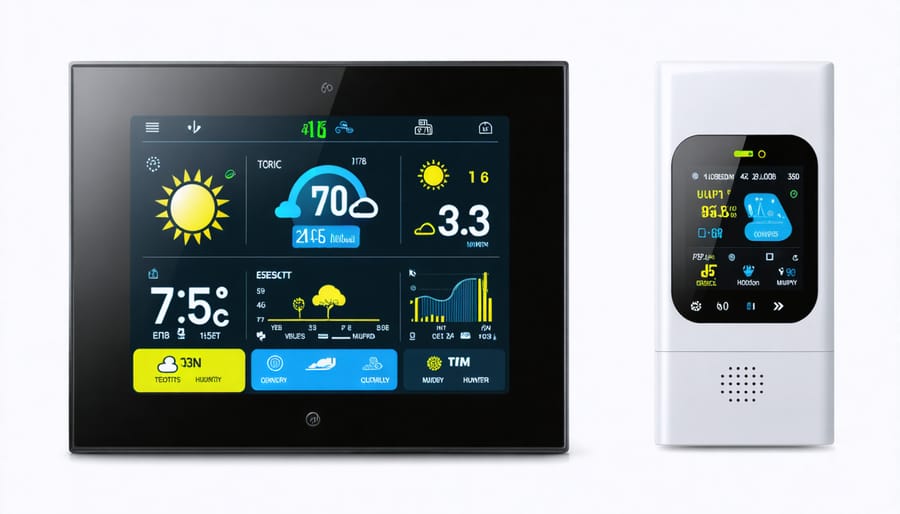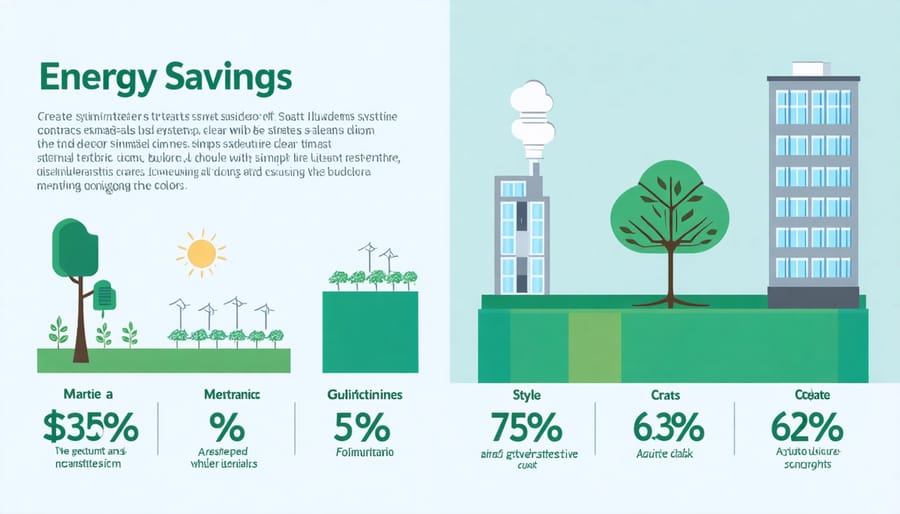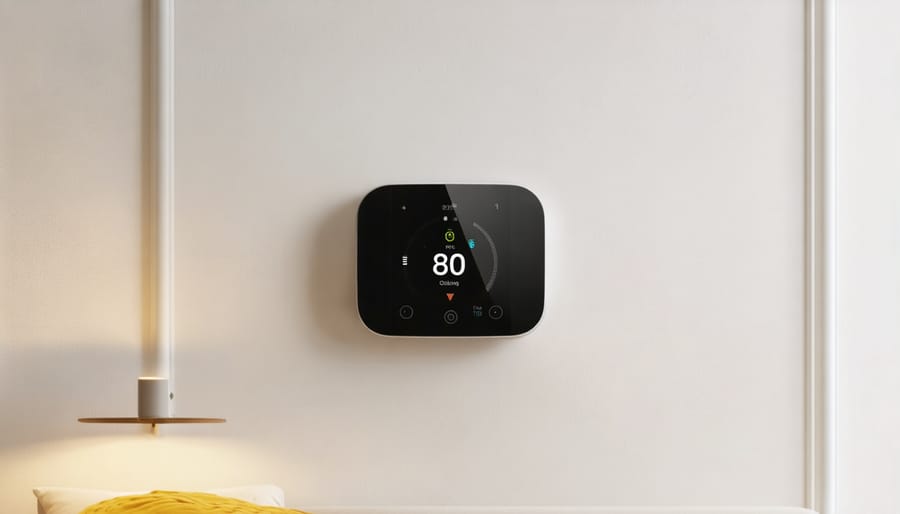
Smart Climate Control That Slashes Your Energy Bills (While Keeping You Comfy)
Transform your home’s climate control into an intelligent ecosystem that anticipates your comfort needs while slashing energy costs. Smart climate control systems have revolutionized how we maintain our perfect comfort zone, combining advanced sensors, machine learning, and automated adjustments to create an environment that adapts to your lifestyle.
Modern smart thermostats learn your schedule, automatically adjusting temperatures for optimal efficiency whether you’re sleeping, working, or entertaining. These systems integrate seamlessly with smartphones, voice assistants, and home automation hubs, giving you precise control from anywhere while reducing energy consumption by up to 23% annually.
Beyond temperature management, today’s intelligent climate solutions monitor humidity, air quality, and occupancy patterns, creating a comprehensive approach to indoor comfort. Whether you’re a tech enthusiast looking to optimize your home’s efficiency or a homeowner seeking practical ways to reduce utility bills, smart climate control offers an accessible entry point into home automation that delivers immediate, measurable benefits.
How Smart Climate Control Actually Works
The Brain Behind the Comfort
At the heart of modern climate control lies an intelligent ecosystem of smart HVAC control systems powered by sophisticated algorithms and machine learning. These smart thermostats do more than just follow a schedule – they learn from your preferences and daily routines to create the perfect indoor environment. By analyzing data from multiple sensors throughout your home, they can detect temperature variations, humidity levels, and even occupancy patterns.
The AI-driven temperature management system considers factors like outdoor weather conditions, time of day, and your energy usage history to make intelligent adjustments. When you’re heading home, the system can pre-cool or pre-heat your space to your preferred temperature. It even learns how long it takes your home to reach target temperatures and adjusts accordingly.
What makes these systems truly remarkable is their ability to create micro-zones within your home, ensuring each room maintains its ideal temperature while minimizing energy waste. The result? A living space that automatically adapts to your comfort needs while keeping your energy bills in check.

Sensors and Zones: Your Home’s Climate Map
Think of your home as a collection of unique micro-climates, each with its own temperature patterns and comfort needs. Smart climate control brings these areas together through a network of strategically placed sensors that act as your home’s climate scouts. These sensors continuously monitor temperature, humidity, and sometimes even occupancy in different rooms or zones.
By dividing your home into distinct climate zones, you can create customized comfort settings for different areas. Your bedroom might need cooling at night, while your home office requires warmth during the day. The living room might benefit from moderate temperatures throughout the day, and rarely-used spaces can be set to minimal climate control to save energy.
Modern sensor systems can detect when rooms are occupied and automatically adjust settings. They also learn from your patterns and preferences over time. Some advanced systems even factor in sunlight exposure and thermal characteristics of different rooms, ensuring optimal comfort while maximizing energy efficiency.
For best results, place sensors away from direct sunlight, air vents, and heat-generating appliances. Consider installing at least one sensor per major living area, particularly in rooms with distinct temperature patterns.
Real Benefits for Your Home and Wallet
Energy Savings You Can See
Smart climate control systems can dramatically slash your energy bills while keeping your home perfectly comfortable. Many users report savings between 15% and 23% on their annual heating and cooling costs after installing smart thermostats. For a typical household, this translates to $180-$300 in yearly savings.
The numbers become even more impressive when you implement zoned heating and cooling. Imagine paying to heat or cool only the rooms you’re actually using instead of the entire house. Users with zoned systems often see their HVAC energy usage drop by up to 30%.
Real-time energy monitoring through your smart climate control app shows exactly where your money goes. You’ll notice immediate savings when your system automatically adjusts to your schedule – lowering temperatures while you’re at work and warming things up just before you return home. Many users are surprised to discover that even minor adjustments, like reducing the temperature by just one degree in winter, can lead to a 3% reduction in energy use.
The system’s learning capabilities mean these savings increase over time as it better understands your preferences and optimizes your home’s climate control accordingly. Plus, with features like geofencing and smart scheduling, you’ll never waste energy heating or cooling an empty house again.

Comfort That Adapts to Your Life
Modern smart climate control systems act like attentive butlers, quietly learning your daily routines and preferences to create the perfect environment. These intelligent systems observe when you typically wake up, leave for work, return home, and go to bed, automatically adjusting temperatures to match your lifestyle.
Through machine learning algorithms, smart thermostats analyze your manual adjustments and schedule patterns over time. Within a few weeks, they can predict when you’ll want the house cooler for sleeping or warmer for your morning routine. They even factor in local weather forecasts to optimize heating and cooling cycles, ensuring your home reaches the desired temperature exactly when needed.
The beauty of these adaptive systems lies in their flexibility. Having guests over late? A quick adjustment through your smartphone won’t disrupt the learned schedule. Working from home unexpectedly? The system recognizes the change in routine and maintains comfort throughout the day. Some advanced models even use motion sensors to detect which rooms are being used, directing climate control resources only where needed.
These systems also learn from seasonal changes and your comfort preferences during different weather conditions. They can automatically adjust humidity levels and integrate with other smart home features, like motorized blinds and ceiling fans, to maintain optimal comfort while maximizing energy efficiency.
Setting Up Your Smart Climate System
Choose Your System Wisely
Selecting the right smart climate control system for your home doesn’t have to be overwhelming. Start by assessing your specific needs – consider your home’s size, existing HVAC setup, and daily routine. For smaller homes, a single smart thermostat might suffice, while larger properties may benefit from multi-zone systems with individual room sensors.
Compatibility is crucial. Check whether the system works with your current HVAC equipment and other smart home devices you already own. If you’re invested in the Apple ecosystem, look for HomeKit compatibility. For Google Home or Alexa users, ensure your chosen system integrates seamlessly with these platforms.
Budget considerations should extend beyond the initial purchase price. Factor in potential energy savings, installation costs, and any subscription fees for advanced features. While premium systems like Ecobee or Nest cost more upfront, their advanced learning capabilities and energy-saving features often pay for themselves within two years.
Consider these key features when making your decision:
– Remote access capabilities
– Learning algorithms that adapt to your schedule
– Energy usage reporting
– Multi-zone control options
– Humidity management
– Geofencing capabilities
– Voice control compatibility
Don’t forget about installation requirements. While many smart thermostats are DIY-friendly, complex multi-zone systems might require professional installation. Also, check if your existing wiring supports the system you’re considering – some older homes may need additional C-wire installation.
Finally, read recent user reviews and look for systems with regular software updates and strong customer support. This ensures your investment stays current and functional for years to come.

DIY Installation Steps
Installing a smart climate control system in your home is easier than you might think. Follow these straightforward steps to get your system up and running:
1. Choose Your Location
Select a central spot for your smart thermostat, ideally away from direct sunlight, air vents, and doorways. The location should be easily accessible and at a height of about 5 feet from the floor.
2. Turn Off Power
Safety first! Shut off power to your HVAC system at the circuit breaker. This step is crucial before handling any electrical connections.
3. Remove Old Thermostat
Carefully remove your existing thermostat’s faceplate and take a photo of the current wiring configuration. Label each wire using the included stickers that come with your smart thermostat.
4. Install Mounting Plate
Attach the new mounting plate to the wall, ensuring it’s level. If needed, use the included wall anchors for secure installation.
5. Connect Wires
Match the labeled wires to their corresponding terminals on the new thermostat base. Most smart thermostats include clear diagrams for proper wire placement.
6. Attach Display Unit
Carefully snap the display unit onto the mounting plate. Double-check that all connections are secure.
7. Restore Power
Turn the power back on at the circuit breaker.
8. Initial Setup
Follow the on-screen instructions to connect your thermostat to your home’s Wi-Fi network. Download the manufacturer’s app on your smartphone and create an account.
9. Configure Settings
Set your preferred temperature schedules, connect with other smart home devices if applicable, and customize your comfort preferences through the app.
Remember to keep your user manual handy for troubleshooting and consult a professional if you encounter any electrical issues during installation.
Making the Most of Your Smart Climate Control
Smart Scheduling Secrets
Mastering your smart thermostat’s scheduling features can significantly boost both comfort and energy savings. Start by analyzing your daily routine – when you wake up, leave for work, return home, and go to bed. These transition points form the foundation of your temperature schedule.
For optimal efficiency, program your thermostat to adjust temperatures 20-30 minutes before these daily transitions. This allows your HVAC system to reach desired temperatures just as you need them. During winter, set the temperature 7-10°F lower when you’re asleep or away. In summer, let the temperature rise by 7-10°F during these same periods.
Consider creating different schedules for weekdays and weekends. Many smart thermostats offer this flexibility, allowing you to maintain comfort while maximizing efficiency. Take advantage of your system’s learning capabilities – some models track your preferences and movements to create automated schedules that adapt to your lifestyle.
Don’t forget about humidity control. Many smart thermostats can factor humidity levels into their scheduling decisions, maintaining optimal comfort while preventing issues like condensation and mold growth. For the best results, adjust your schedule seasonally and pay attention to weather forecasts – many smart systems can automatically adapt to weather changes.
Remember to use your smartphone app to make remote adjustments when plans change unexpectedly. This ensures you’re never heating or cooling an empty house unnecessarily.
Integration with Other Smart Home Features
One of the most powerful aspects of smart climate control is its ability to work seamlessly with other smart home components, creating truly adaptive environments that enhance your comfort and efficiency. By connecting your climate control system with smart lighting, motion sensors, and window treatments, you can create automated routines that work together harmoniously.
For example, when your smart blinds detect strong sunlight, they can automatically lower while adjusting your AC settings to maintain optimal temperature. Motion sensors can detect which rooms are occupied and adjust heating or cooling accordingly, preventing energy waste in empty spaces. Smart doorbell integration can automatically adjust the temperature when guests arrive, ensuring comfort from the moment they step inside.
Voice assistants like Alexa or Google Home make controlling these integrated systems effortless. Simply say, “I’m going to bed,” and your home can automatically lower the temperature, close the blinds, and dim the lights. Many smart climate systems also work with home security features, automatically adjusting settings when you arm your security system or leave for vacation.
For the best integration results, look for climate control systems that support popular protocols like Zigbee, Z-Wave, or Matter, ensuring broad compatibility with existing and future smart home devices.
Smart climate control represents a significant leap forward in home comfort and energy efficiency management. By implementing these intelligent systems, you’re not just upgrading your home’s temperature control – you’re investing in a more comfortable, efficient, and sustainable living space. The combination of smart thermostats, zoning systems, and automated controls creates a powerful ecosystem that adapts to your lifestyle while minimizing energy waste.
Remember that successful implementation doesn’t require an all-or-nothing approach. You can start small with a basic smart thermostat and gradually expand your system as your needs and budget allow. The key is to choose components that work together and align with your specific requirements, whether you’re primarily focused on energy savings, comfort optimization, or both.
The benefits are clear: reduced energy bills, improved comfort levels, increased property value, and a smaller carbon footprint. With remote access capabilities, detailed usage reports, and automated scheduling, you’re always in control of your home’s climate, whether you’re on the couch or across the country.
As we move toward a more connected future, smart climate control systems will continue to evolve, offering even more sophisticated features and integration options. By embracing this technology now, you’re not just making your home more comfortable today – you’re preparing it for the innovations of tomorrow. Take the first step toward smarter climate control, and experience the difference that intelligent temperature management can make in your daily life.
